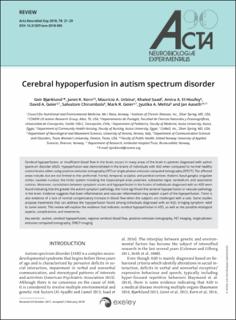| dc.contributor.author | Bjørklund, Geir | |
| dc.contributor.author | Kern, Janet K | |
| dc.contributor.author | Urbina, Mauricio A. | |
| dc.contributor.author | Saad, Khaled | |
| dc.contributor.author | El-Houfey, Amira A. | |
| dc.contributor.author | Geier, David A. | |
| dc.contributor.author | Chirumbolo, Salvatore | |
| dc.contributor.author | Geier, Mark R. | |
| dc.contributor.author | Mehta, Jyutika A. | |
| dc.contributor.author | Aaseth, Jan | |
| dc.coverage.spatial | Poland | en_US |
| dc.date.accessioned | 2020-03-20T16:39:50Z | |
| dc.date.available | 2020-03-20T16:39:50Z | |
| dc.date.issued | 2018 | |
| dc.identifier.citation | Acta Neurobiol Exp (Wars). 2018;78(1):21-29. DOI: 10.21307/ane‑2018‑005 | en_US |
| dc.identifier.issn | 0065-1400 | |
| dc.identifier.uri | https://hdl.handle.net/11250/2647919 | |
| dc.description.abstract | Cerebral hypoperfusion, or insufficient blood flow in the brain, occurs in many areas of the brain in patients diagnosed with autism spectrum disorder (ASD). Hypoperfusion was demonstrated in the brains of individuals with ASD when compared to normal healthy control brains either using positron emission tomography (PET) or single‑photon emission computed tomography (SPECT). The affected areas include, but are not limited to the: prefrontal, frontal, temporal, occipital, and parietal cortices; thalami; basal ganglia; cingulate cortex; caudate nucleus; the limbic system including the hippocampal area; putamen; substantia nigra; cerebellum; and associative cortices. Moreover, correlations between symptom scores and hypoperfusion in the brains of individuals diagnosed with an ASD were found indicating that the greater the autism symptom pathology, the more significant the cerebral hypoperfusion or vascular pathology in the brain. Evidence suggests that brain inflammation and vascular inflammation may explain a part of the hypoperfusion. There is also evidence of a lack of normal compensatory increase in blood flow when the subjects are challenged with a task. Some studies propose treatments that can address the hypoperfusion found among individuals diagnosed with an ASD, bringing symptom relief to some extent. This review will explore the evidence that indicates cerebral hypoperfusion in ASD, as well as the possible etiological aspects, complications, and treatments. | en_US |
| dc.language.iso | eng | en_US |
| dc.rights | Navngivelse 4.0 Internasjonal | * |
| dc.rights.uri | http://creativecommons.org/licenses/by/4.0/deed.no | * |
| dc.subject | autism | en_US |
| dc.subject | cerebral hypoperfusion | en_US |
| dc.subject | regional cerebral blood flow | en_US |
| dc.subject | positron emission tomography | en_US |
| dc.subject | PET imaging | en_US |
| dc.subject | single‑photon emission computed tomography | en_US |
| dc.subject | SPECT imaging | en_US |
| dc.title | Cerebral hypoperfusion in autism spectrum disorder | en_US |
| dc.type | Peer reviewed | en_US |
| dc.type | Journal article | en_US |
| dc.description.version | publishedVersion | en_US |
| dc.rights.holder | Copyrights Acta Neurobiol Exp (Wars). License : (CC-BY-4.0) | en_US |
| dc.source.pagenumber | 21-29 | en_US |
| dc.source.volume | 78 | en_US |
| dc.source.journal | Acta Neurobiologiae Experimentalis | en_US |
| dc.source.issue | 1 | en_US |

